How to Bleach Duvet: Whitening Tips for Bedding
You know the feeling when you slip into a freshly bleached, crisp white duvet and it feels like a breath of fresh air? It’s a simple pleasure that can elevate the comfort and cleanliness of your bedding.
But achieving that level of brightness and freshness can be a bit of a challenge, especially when it comes to duvets. You might be wondering about the best methods to whiten your duvet and keep it looking its best.
Well, fear not, because you’re about to discover effective and safe ways to bleach your duvet and maintain its pristine appearance.
Whether you’re dealing with everyday stains or just want to revitalize the color, these whitening tips for bedding will leave you with a sense of satisfaction and a cozy, bright duvet.
Key Takeaways
- Consider the whitening power and potential fabric damage when selecting bleach.
- Pre-soak the duvet in warm or hot water for at least one hour with whitening agents like white vinegar, lemon juice, or borax.
- Add ½ cup of bleach and regular laundry detergent to the washing machine drum for effective stain removal and brightness restoration.
- Rinse the duvet in hot water to remove bleach or cleaning agents and air-dry in the sun for natural bleaching properties.
Selecting the Right Bleach
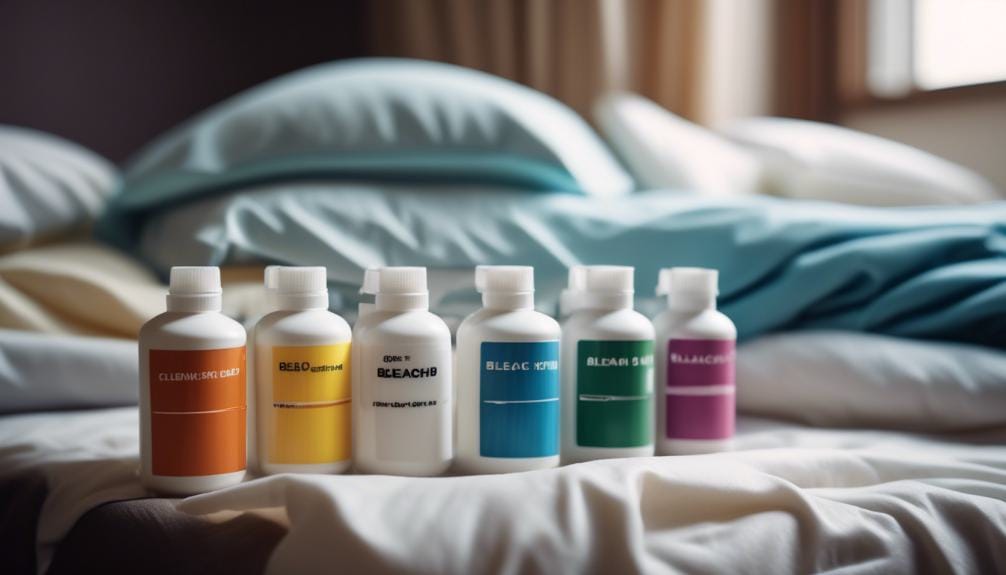
When selecting the right bleach for whitening your duvet and bedding, consider the whitening power and potential fabric damage to ensure optimal results.
If you’re aiming for natural whitening and gentle care for your bedding, opt for a non-chlorine oxygen bleach. This alternative offers effective whitening without compromising the integrity of your sheets and duvet.
On the other hand, if tough stains are a concern, hydrogen peroxide is an excellent choice. It not only aids in stain removal but also maintains the fabric’s quality.
Liquid bluing is another option to counteract any yellow undertones in your sheets.
Prioritize selecting a suitable whitening agent based on the type of stains and fabric sensitivity, ensuring that your bedding receives the best care for a pristine, whitened finish.
Preparing the Duvet for Bleaching
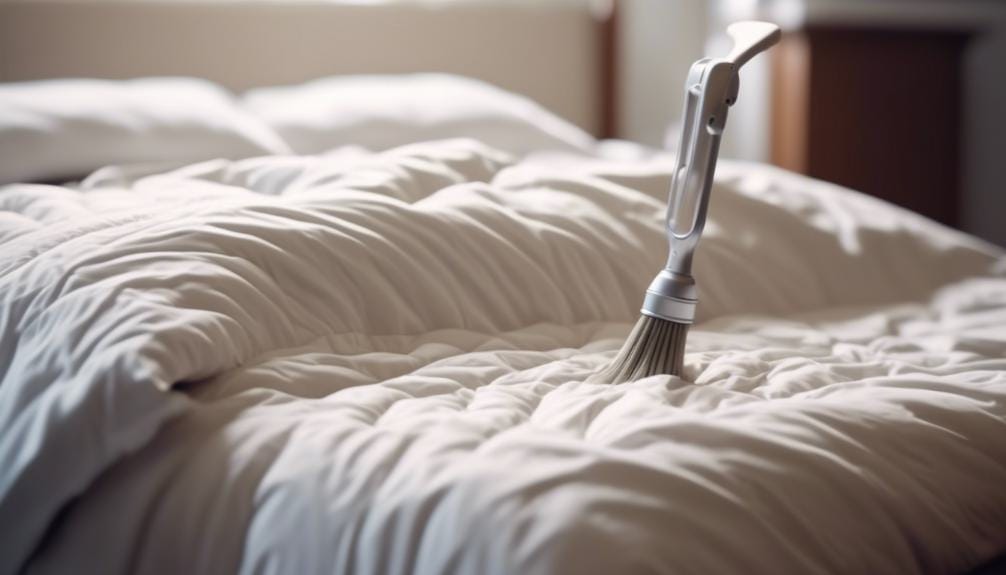
If you want to ensure your duvet receives the best care for optimal whitening results, the first step is to pre-soak it in warm or hot water for at least one hour, incorporating whitening agents such as white vinegar, lemon juice, or borax as needed. Here’s a helpful table to guide you through the process:
| Pre-Soaking Agents | Amount | Water Volume |
|---|---|---|
| White Vinegar | ½ cup per gallon | Warm or hot |
| Lemon Juice | ½ cup per gallon | Warm or hot |
| Borax | ½ cup per gallon | Warm or hot |
Applying the Bleach
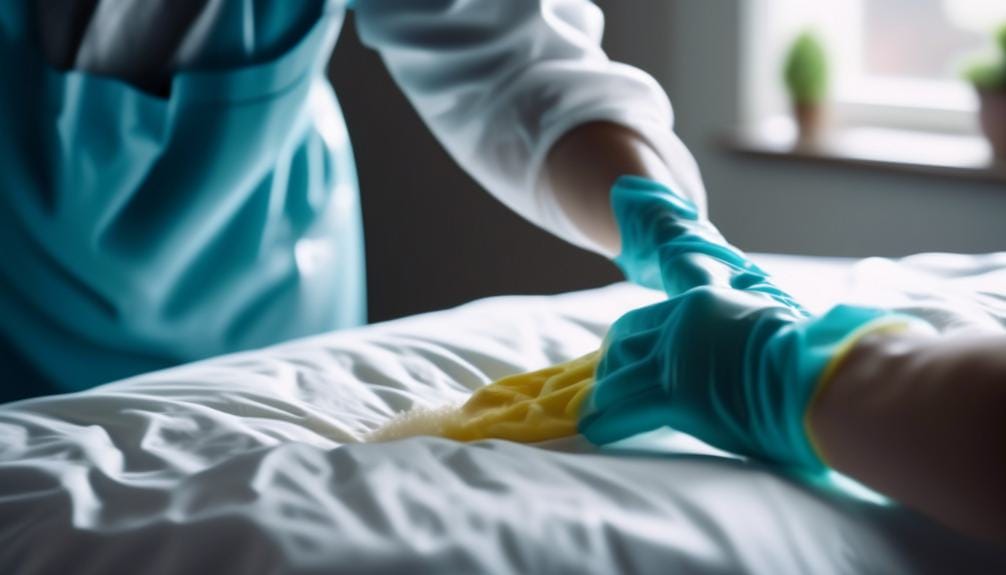
To effectively apply bleach to your duvet for whitening, follow these steps:
- Add ½ cup of bleach to the washing machine drum.
- Add regular laundry detergent to the drum as well.
- Ensure that the duvet covers and white bedding are thoroughly soaked in the whitening solution during the wash cycle.
- The bleach acts as a powerful bleaching agent, effectively removing stains and restoring the brightness of your white sheets.
- If you prefer a natural alternative, you can add ½ cup of lemon juice or ½ cup of borax (sodium borate) to the wash along with your regular detergent to help whiten the sheets.
- After the wash cycle is complete, hang the bedding out in the sun to enhance the bleaching effect and eliminate any remaining yellowing.
Rinsing and Drying the Duvet
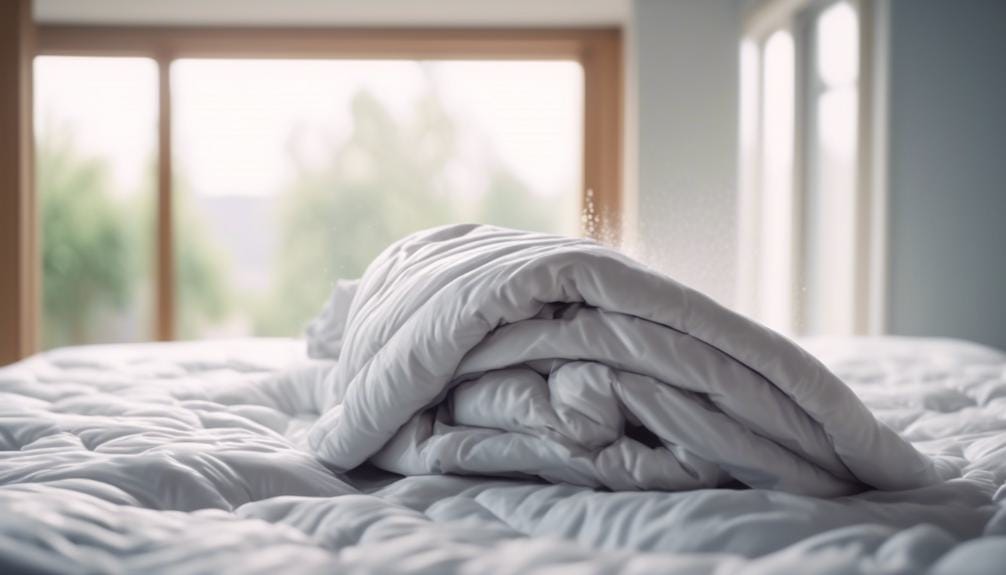
After applying the bleach or natural whitening solution to your duvet, the next step is to thoroughly rinse and dry the bedding to ensure a bright, fresh result. Here’s what you need to do:
- Rinse the duvet in hot water to remove all traces of bleach or other cleaning agents.
- If using a washing machine, run it through a regular laundry cycle with hot water.
- Hang the duvet to air-dry in the sun to benefit from natural bleaching properties and fresh air.
- Ensure the duvet is completely dry before putting it back on the bed to prevent mildew or musty odors.
- If machine drying, use a low heat setting to avoid damaging the duvet fabric.
- Fluff and air the duvet periodically during the drying process to maintain its loft and prevent clumping.
Additional Tips for Maintaining Whiteness
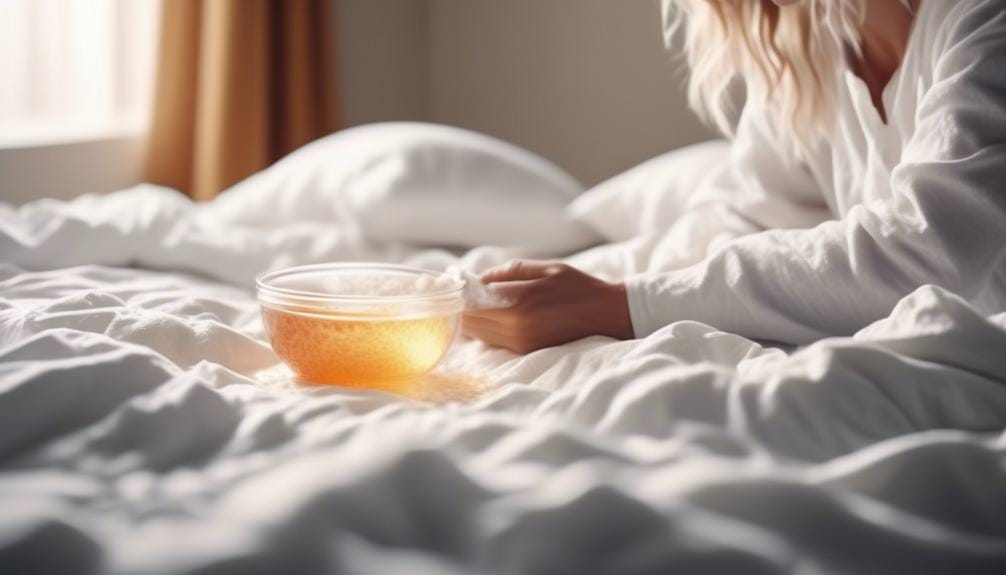
For enhanced whiteness maintenance, consider incorporating non-chlorine oxygen bleach into your regular laundry routine. Use it in every wash to keep your white sheets looking bright.
Additionally, air-dry your sheets in the sun whenever possible to benefit from its natural bleaching properties. Washing your sheets every four to five days can prevent yellow stains caused by sweat and body oil.
When doing laundry, separate lights and darks to prevent dingy sheets and reinforce with whitening ingredients like bleach, vinegar, or borax. It’s also helpful to use an oil and water cleanser on your face to prevent yellow-stained pillowcases.
These tips, along with using the right laundry detergent, baking soda, and vinegar, will help you maintain the whiteness of your bedding and prevent stains.
Frequently Asked Questions
How Do I Get My White Duvet White Again?
To get your white duvet white again, try soaking it in a solution of lemon juice and hot water, adding vinegar and baking soda to the washing machine, pre-soaking in a borax and water solution, or using bleach.
How Do You Bleach a Duvet?
To bleach a duvet, start by pre-soaking it in warm water with vinegar or lemon juice. Then, wash it with a whitening agent like baking soda, vinegar, bleach, or hydrogen peroxide. Finally, air-dry it in the sun for natural bleaching properties.
How Do You Whiten Bedding With Bleach?
To whiten bedding with bleach, add the recommended amount to the washing machine and run a regular cycle. Remember to follow the manufacturer’s instructions for both the bleach and your bedding to avoid damaging fabrics.
How Do Hotels Keep Their Sheets so White?
Hotels keep their sheets white by using chlorine bleach. However, for household use, regular bleaching may weaken fabric fibers. It’s essential to follow proper washing and care instructions for bedding and consider replacing sheets if whitening efforts are unsuccessful.
Conclusion
In conclusion, there are different methods for bleaching duvets and whitening bedding. One option is to use natural ingredients like lemon, vinegar, and baking soda. These can be effective in removing stains and brightening fabrics. Another option is to use commercial products such as bleach and liquid bluing, which are specifically designed for whitening purposes.
Regardless of the method chosen, it is crucial to carefully follow the instructions provided and take proper precautions when dealing with chemicals. This ensures both safety and optimal results.
In addition to using bleaching agents, regular washing in hot water is important for maintaining the whiteness of bedding. It is also advisable to separate lights and darks during washing to prevent color transfer.
Lastly, proper maintenance is essential for preventing yellowing and preserving the freshness of bedding. This includes storing bedding in a clean, dry place and avoiding exposure to sunlight or excessive moisture.
By considering these factors and choosing the method that works best for you, you can enjoy fresh and bright bedding for a longer period of time.
